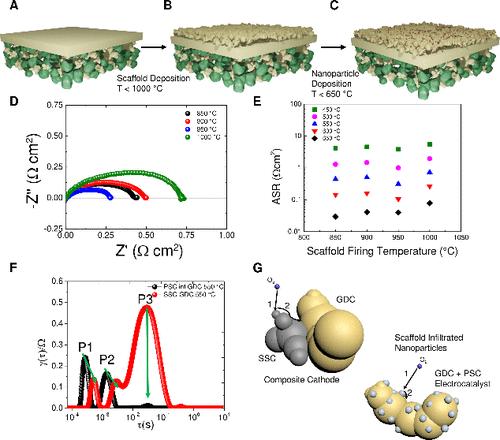当前位置:
X-MOL 学术
›
ACS Appl. Mater. Interfaces
›
论文详情
Our official English website, www.x-mol.net, welcomes your feedback! (Note: you will need to create a separate account there.)
Scaffold Infiltrated Cathodes for Low-Temperature Solid Oxide Fuel Cells
ACS Applied Materials & Interfaces ( IF 8.3 ) Pub Date : 2024-07-22 , DOI: 10.1021/acsami.4c04627 Ian A. Robinson 1, 2 , Samuel A. Horlick 1, 3 , Yi-Lin Huang 1, 2 , Alexandra P. Lam 1, 3 , Sridhar S. Ganti 1, 3 , Eric D. Wachsman 1, 2, 3
ACS Applied Materials & Interfaces ( IF 8.3 ) Pub Date : 2024-07-22 , DOI: 10.1021/acsami.4c04627 Ian A. Robinson 1, 2 , Samuel A. Horlick 1, 3 , Yi-Lin Huang 1, 2 , Alexandra P. Lam 1, 3 , Sridhar S. Ganti 1, 3 , Eric D. Wachsman 1, 2, 3
Affiliation

|
Lowering the operating temperature of solid oxide fuel cells (SOFCs) and electrolysis cells (SOECs) to reduce system cost and increase lifetime is the key to widely deploy this highly efficient energy technology, but the high cathode polarization losses at low temperatures limit overall cell performance. Here we demonstrate that by engineering a universal ceria-based scaffold with infiltrated nanoscale electrocatalysts, a low cathode polarization <0.25 Ω·cm2 with remarkably high performance 1 W/cm2 at 550 °C is achieved. The combination of low processing and operating temperature restrains the nanosized electrocatalysts, not only allowing fast oxygen transport but also providing an essential electronically connective network to facilitate electrochemical reactions without requiring the high-temperature processing of a separate cathode layer. Moreover, excellent SOFC durability was demonstrated for over 500 h. This work shows a promising pathway to reduce processing/system costs with all scalable ceramic processing techniques for the future development of low-temperature SOFCs and SOECs.
中文翻译:

用于低温固体氧化物燃料电池的支架渗透阴极
降低固体氧化物燃料电池(SOFC)和电解电池(SOEC)的工作温度以降低系统成本并延长使用寿命是广泛部署这种高效能源技术的关键,但低温下的高阴极极化损耗限制了电池的整体性能。在这里,我们证明,通过设计具有渗透纳米级电催化剂的通用二氧化铈基支架,可在 550 ℃ 下实现低阴极极化 <0.25 Ω·cm 2 和极高的性能 1 W/cm 2 达到°C。低加工和操作温度的结合限制了纳米级电催化剂,不仅允许快速氧气传输,而且还提供必要的电子连接网络以促进电化学反应,而不需要单独的阴极层的高温加工。此外,SOFC 的耐久性已超过 500 小时。这项工作为低温 SOFC 和 SOEC 的未来发展展示了一条利用所有可扩展陶瓷加工技术降低加工/系统成本的有前景的途径。
更新日期:2024-07-24
中文翻译:

用于低温固体氧化物燃料电池的支架渗透阴极
降低固体氧化物燃料电池(SOFC)和电解电池(SOEC)的工作温度以降低系统成本并延长使用寿命是广泛部署这种高效能源技术的关键,但低温下的高阴极极化损耗限制了电池的整体性能。在这里,我们证明,通过设计具有渗透纳米级电催化剂的通用二氧化铈基支架,可在 550 ℃ 下实现低阴极极化 <0.25 Ω·cm 2 和极高的性能 1 W/cm 2 达到°C。低加工和操作温度的结合限制了纳米级电催化剂,不仅允许快速氧气传输,而且还提供必要的电子连接网络以促进电化学反应,而不需要单独的阴极层的高温加工。此外,SOFC 的耐久性已超过 500 小时。这项工作为低温 SOFC 和 SOEC 的未来发展展示了一条利用所有可扩展陶瓷加工技术降低加工/系统成本的有前景的途径。












































 京公网安备 11010802027423号
京公网安备 11010802027423号